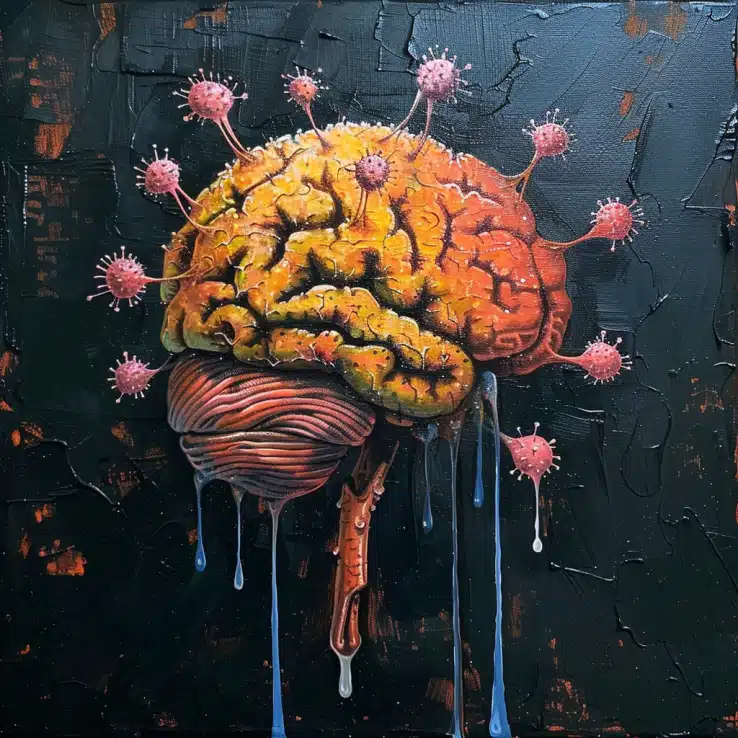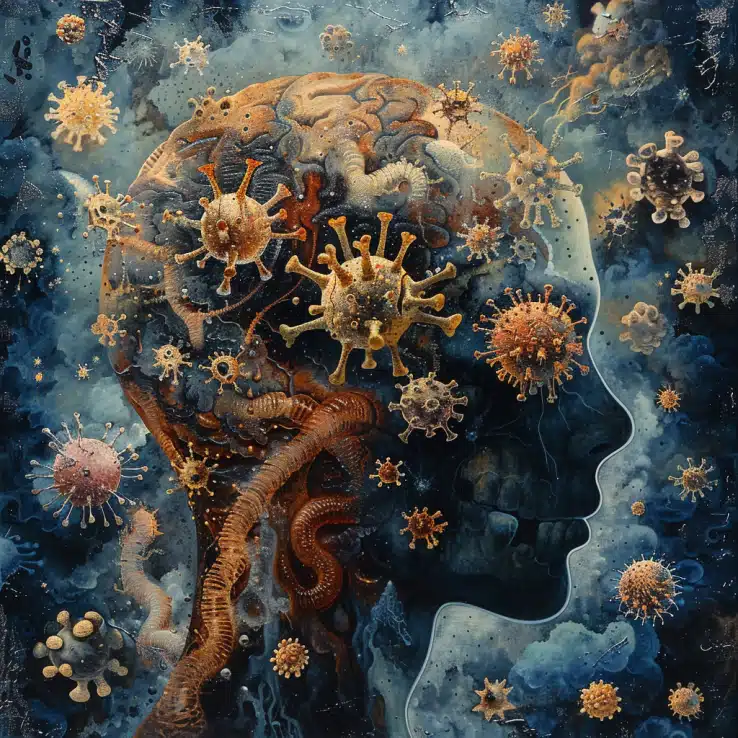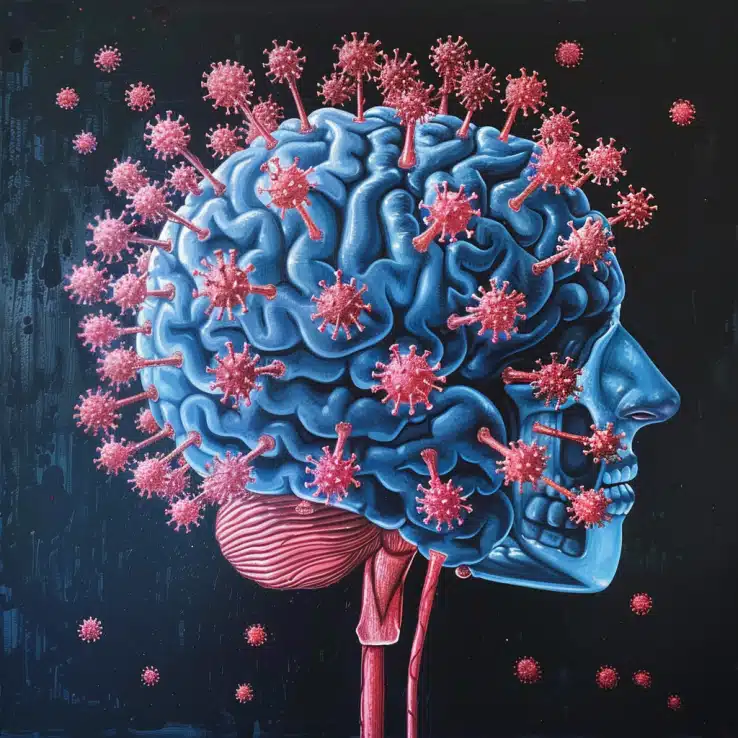A study found that adults recovering from their first COVID-19 infection more than 1-year ago have higher levels of fatigue and other chronic neuropsychiatric symptoms, influenced by vaccination status and socioeconomic factors.
Highlights:
- Adults who had their first COVID-19 infection over 1-year ago reported significantly higher fatigue levels compared to those who never had COVID-19 (p < 0.001).
- Lack of COVID vaccination before the first infection and higher material deprivation before the pandemic were linked to a higher load of chronic neuropsychiatric symptoms.
- Chronic neuropsychiatric symptoms clustered into two major groups (cognitive complaints-fatigue and anxiety-depression) and one minor group (headache-dizziness).
- Material deprivation predicted higher symptoms in both major clusters, while lack of vaccination only predicted higher symptoms in the cognitive complaints-fatigue cluster.
- The study highlights the complex interplay between biological and socioeconomic factors in the persistence of chronic neuropsychiatric symptoms post-COVID.
Source: Translational Psychiatry (2024)
Prevalence of Post-COVID Neuropsychiatric Symptoms
Prevalence
Global Health: Post-acute COVID syndrome (PACS), or ‘Long-COVID,’ is now recognized as a significant global health issue, with neuropsychiatric symptoms being among the most common non-respiratory complications.
Common Symptoms: Studies have reported varying prevalence rates, but common neuropsychiatric symptoms include mood and anxiety disorders, sleep disturbances, fatigue, and cognitive complaints, often referred to as “brain fog.”
Persistent Symptoms: Research indicates that a substantial portion of COVID-19 survivors experience persistent symptoms, with some studies estimating that 20-30% of individuals report ongoing neuropsychiatric issues several months post-infection.
Previous Research
Early Observations
Initial studies identified that a significant number of COVID-19 patients experienced neuropsychiatric symptoms during the acute phase of the illness.
Symptoms such as anxiety, depression, and post-traumatic stress disorder (PTSD) were commonly reported in the months following recovery.
Longitudinal Studies
Long-term studies have shown that these symptoms can persist for more than a year post-infection.
For instance, a study published in “The Lancet” reported that 12 months after infection, many patients still experienced neuropsychiatric symptoms, with fatigue and cognitive dysfunction being the most persistent.
MRI & Brain Changes
Imaging studies have provided evidence of structural brain changes in individuals with PACS.
A longitudinal MRI study demonstrated reductions in grey matter and cortical changes in those suffering from long-term COVID-19 symptoms, supporting the hypothesis of lasting brain impact.
Risk Factors
Research has identified several risk factors for developing long-term neuropsychiatric symptoms, including the severity of the initial infection, pre-existing mental health conditions, and lack of vaccination.
Socioeconomic factors, such as material deprivation, have also been highlighted as significant predictors.
Major Findings: Post-COVID Neuropsychiatric Symptoms (2024 Study)

1. Higher Levels of Fatigue
Observation: People who had COVID-19 over a year ago experience significantly higher levels of fatigue compared to those who never had the virus.
Detail: Despite similar sleep durations and no significant differences in symptoms like depression, anxiety, or post-traumatic stress, the post-COVID group reported feeling more tired.
2. Effects of Vaccination & Socioeconomic Status
Lack of Vaccination
Observation: Those who were not vaccinated before their first COVID-19 infection had more chronic neuropsychiatric symptoms.
Detail: Vaccination before infection seemed to protect against long-term symptoms, especially those related to cognitive issues and fatigue.
Material Deprivation
Observation: Higher levels of material deprivation (economic hardship) before the pandemic were linked to a greater number of chronic neuropsychiatric symptoms.
Detail: Socioeconomic status played a significant role in the severity and number of long-term symptoms experienced post-COVID.
3. Specific Symptom Clusters
Major Clusters:
A. Cognitive Complaints & Fatigue
- Symptoms: Memory problems, difficulty concentrating, daytime sleepiness, and fatigue.
- Predictors: Both lack of vaccination and higher material deprivation increased symptoms in this cluster.
B. Anxiety & Depression
- Symptoms: Anxiety, depression, insomnia, loss of interest or pleasure, and post-traumatic stress.
- Predictors: Higher material deprivation was linked to increased symptoms in this cluster.
C. Minor Cluster:
Headache & Dizziness
- Symptoms: Persistent headaches and dizziness.
- Predictors: This cluster was less influenced by the identified risk factors compared to the major clusters.
4. Increased Medical Diagnoses & Resource Utilization
New Diagnoses
Observation: The post-COVID group reported more new medical conditions since the pandemic began, such as chronic pain, hypertension, and heart disease.
Detail: These individuals also had more hospital visits and consultations, reflecting an increased need for medical care.
Psychiatric Conditions
Observation: Those with a high number of persistent neuropsychiatric symptoms also reported more new psychiatric diagnoses and suicidal thoughts.
Detail: This suggests a significant mental health burden among those severely affected by long-term COVID symptoms.
5. No Significant Differences in Cognitive Task Performance
Observation: Despite subjective complaints about cognitive function, there were no significant differences in objective cognitive task performance between those with high and low symptom loads.
Detail: This might indicate that subjective feelings of cognitive decline do not always align with measurable impairments or that the tools used to measure cognitive function in this study were not sensitive enough.
Related: Olfactory Dysfunction Predicts Long-COVID Fatigue & Cognitive Deficits after 1-Year
Study Details: Post-COVID Neuropsychiatric Manifestations (2024)

Sample
Post-COVID Group
Adults aged 18-65 who experienced their first COVID-19 infection before January 2022 (pre-Omicron) and had not been re-infected in the last year.
Size: 223 participants.
Control Group
Adults aged 18-65 with no history of COVID-19, matched with the post-COVID group based on age, gender, ethnicity, pre-pandemic health, and socioeconomic status.
Size: 224 participants.
Methods
Recruitment
Participants were recruited via community posters, social media, and university email newsletters from August 2022 to March 2023.
Advertisements were available in both Chinese (traditional characters) and English.
Data Collection
Participants completed app-based questionnaires on demographic, socioeconomic, and health status at two time points: December 2019 (pre-pandemic) and at the time of assessment.
They also filled out a checklist of COVID-19 symptoms, mental health, sleep health measures, and neurocognitive tests.
Measures
Mental Health: Assessed using the Patient Health Questionnaire-9 (PHQ-9), General Anxiety Disorder-7 (GAD-7), Impact of Event Scale-Revised (IES-r), Insomnia Severity Index (ISI), Chalder Fatigue Scale (CFS), and CAGE questionnaire for alcoholism.
Sleep Health: Monitored through a seven-day sleep diary.
Cognitive Function: Evaluated using app-based tasks like the psychomotor vigilance test (PVT), digital symbol substitution test (DSST), N-back test, and alternate finger-tapping test.
Limitations
- Convenient Sampling: The study used a convenient sampling method, which may limit the generalizability of the findings.
- Cross-Sectional Design: Being a cross-sectional study, it cannot establish causality between COVID-19 and the chronic neuropsychiatric symptoms observed.
- Recall Bias: Pre-pandemic data on socioeconomic and health status were based on participant recall, which could be inaccurate.
- Sample Size: The relatively modest sample size may limit the statistical power of the study.
- Self-Reported Data: Infection status and symptoms were self-reported, which could affect data reliability.
- Uncontrolled Testing Environment: Cognitive tasks were completed via a mobile app in uncontrolled environments, possibly increasing variance in performance results.
- No Multiple Comparison Correction: The study did not correct for multiple comparisons in its statistical tests, increasing the risk of false positive results.
Potential Mechanisms of Post-COVID Symptoms
Neuroinflammation
COVID-19 may trigger an inflammatory response in the brain.
The virus can lead to the release of pro-inflammatory cytokines, causing neuroinflammation which can affect brain function and lead to symptoms like fatigue, cognitive impairment, and mood disorders.
Immune Dysregulation
Prolonged immune system activation and dysregulation can occur after COVID-19.
Persistent immune activation may lead to ongoing symptoms by affecting the central nervous system and contributing to chronic fatigue, depression, and anxiety.
Microvascular Pathology
Damage to small blood vessels in the brain could be a factor.
COVID-19 can cause endothelial dysfunction, leading to microvascular damage and reduced blood flow to the brain, which might result in cognitive deficits and other neuropsychiatric symptoms.
Direct Viral Effects
The virus itself may directly infect the brain.
SARS-CoV-2 may enter the brain through the olfactory bulb or via blood circulation, potentially causing direct neuronal damage and contributing to symptoms like headaches, dizziness, and cognitive impairment.
Autoimmune Responses
COVID-19 may trigger autoimmune reactions.
The body’s immune response to the virus might mistakenly attack its own neural tissues, leading to chronic inflammation and symptoms such as fatigue, brain fog, and mood disturbances.
Neurotransmitter Imbalances
COVID-19 might disrupt neurotransmitter systems.
The virus or the immune response to it could affect neurotransmitter levels, such as serotonin and dopamine, leading to anxiety, depression, and sleep disturbances.
Psychological Stress
The stress and trauma of experiencing COVID-19 can have lasting effects.
The psychological impact of a severe illness, along with social isolation and other stressors associated with the pandemic, can contribute to long-term neuropsychiatric symptoms.
Genetic Predisposition
Some individuals may be genetically predisposed to long-term symptoms.
Genetic factors could influence susceptibility to severe and persistent symptoms, possibly through variations in immune response, inflammation, and neural repair mechanisms.
References
- Study: Chronic post-COVID neuropsychiatric symptoms persisting beyond one year from infection: a case-control study and network analysis (2024)
- Authors: Steven Wai Ho Chau et al.







